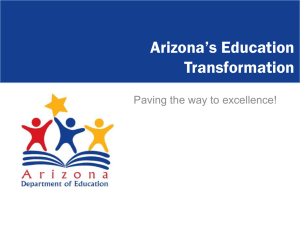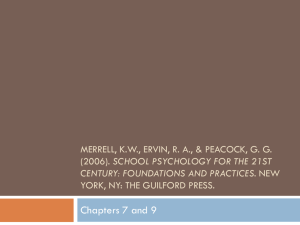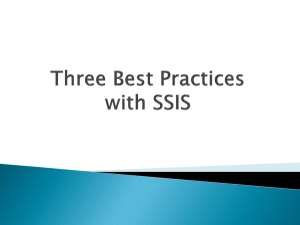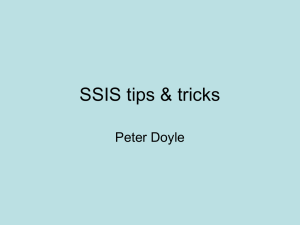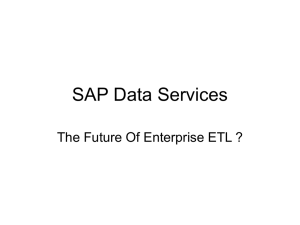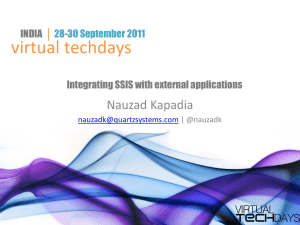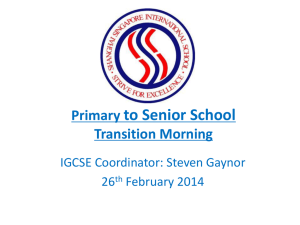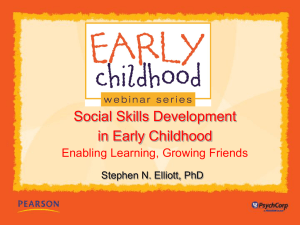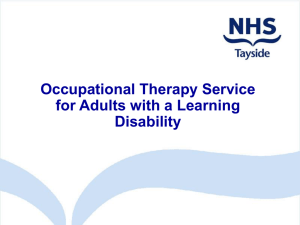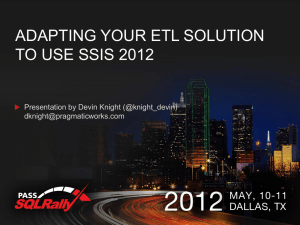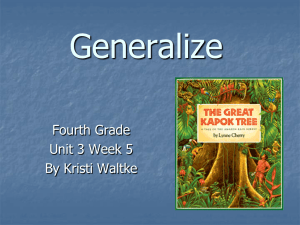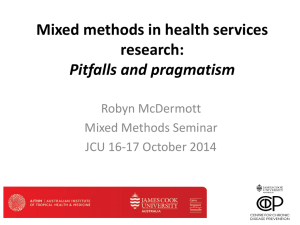Small Group Social Skill Instruction as a Tier 2 Intervention
advertisement
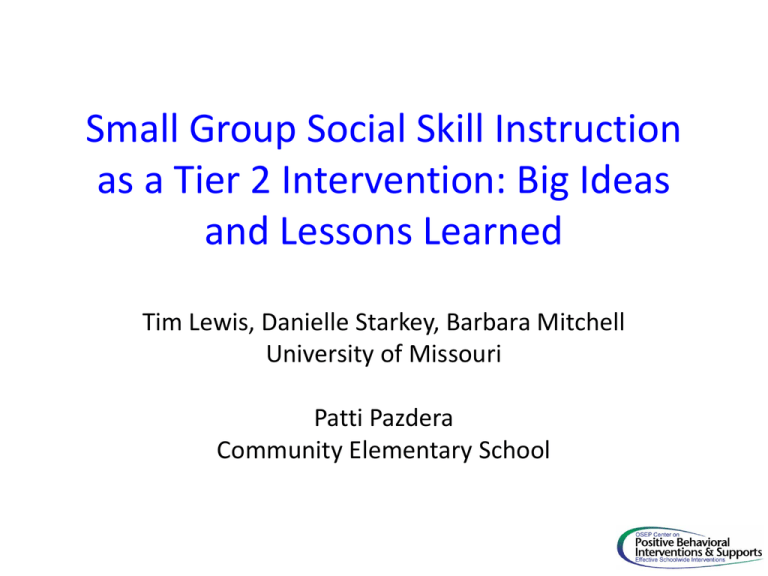
Small Group Social Skill Instruction
as a Tier 2 Intervention: Big Ideas
and Lessons Learned
Tim Lewis, Danielle Starkey, Barbara Mitchell
University of Missouri
Patti Pazdera
Community Elementary School
Designing School-Wide Systems for Student Success
Academic Systems
Behavioral Systems
Intensive, Individual Interventions
•Individual Students
•Assessment-based
•High Intensity
1-5%
Targeted Group Interventions
•Some students (at-risk)
•High efficiency
•Rapid response
Universal Interventions
•All students
•Preventive, proactive
5-10%
80-90%
1-5%
Intensive, Individual Interventions
•Individual Students
•Assessment-based
•Intense, durable procedures
5-10%
Targeted Group Interventions
•Some students (at-risk)
•High efficiency
•Rapid response
80-90%
Universal Interventions
•All settings, all students
•Preventive, proactive
Universal
• Matrix of school-wide expectations across
settings
– List of problems = replacements
– “Scope and sequence” of social skills
• Simple lessons with activities
• Year long teaching schedule
– Stages of Learning
Benton
I am….
All Settings
Classroo
m
Hallways
Cafeteria
Bathrooms
Playground
Assemblies
Safe
•Keep bodies
calm in line
•Report any
problems
•Ask
permission to
leave any
setting
Maintain
personal
space
Walk
Stay to the
right on
stairs
Banisters
are for
hands
•Walk
•Push in
chairs
•Place trash
in trash can
Wash hands with
soap and water
Keep water in the
sink
One person per
stall
Use equipment for
intended purpose
Wood chips are for
the ground
Participate in
school approved
games only
Stay in approved
areas
Keep body to self
•Walk
•Enter and exit
gym in an
orderly manner
Respect
ful
•Treat others
the way you
want to be
treated
•Be an active
listener
•Follow adult
direction(s)
•Use polite
language
•Help keep
the school
orderly
Be
honest
Take
care of
yourself
Walk
quietly so
others can
continue
learning
Eat only
your food
Use a
peaceful
voice
Allow for privacy
of others
Clean up after self
•Line up at first
signal
•Invite others who
want to join in
•Enter and exit
building peacefully
•Share materials
•Use polite
language
Be an active
listener
Applaud
appropriately to
show
appreciation
A
Learner
•Be an active
participant
•Give full
effort
•Be a team
player
•Do your job
•Be a risk
taker
•Be
prepared
•Make
good
choices
Return to
class
promptly
•Use proper
manners
•Leave
when adult
excuses
•Follow bathroom
procedures
•Return to class
promptly
•Be a problem
solver
•Learn new games
and activities
•Raise your
hand to share
•Keep
comments and
questions on
topic
Small Group
• Students displaying social skill challenges as
primary concern
• Set of skills targeting common concerns
• Set of clear generalization strategies for
classroom teachers to implement
Individual
•
•
•
•
Social skill deficits / performance problem
Guided by functional behavioral assessment
Replacement “social skill” meets need
Environment supports use of new skill
– High rates of reinforcement
– New skill accesses previous function of problem
behavior
Social Skill Instruction
Definitions
Functional Perspective
Best Practices
Definition- Social Competence
“Social competence represents an evaluative
term based on judgments (given certain
criteria) that a person has performed a task
adequately. These judgments may be based on
opinions of significant others (e.g., parents,
teachers), comparisons to explicit criteria (e.g.,
number of social tasks correctly performed in
relation to some criterion), or comparisons to
some normative sample.” (Gresham, 1986, p. 146)
Definition -Social Skills
Social skills are defined as "those behaviors which,
within a given situation, predict important social
outcomes" (Gresham, 1986, p. 5).
a) social skills are simply one facet of an overall
construct of social competence – if taught in isolation
you will never reach the larger objective of improved
social functioning, b) they are linked to the
environment in which they occur, and c) targeted
skills should reflect the larger school set of behavioral
expectations
Functional Perspective
“Inappropriate” social skills meet student need
and until we teach an “appropriate” skill and alter
the environment, they will continue to use the
inappropriate
Social Competence Assessment
Context
Process
{social skills}
Functional A nalysis
Outcome
Social Task
Behavior
Effective
?
No
No
Rating Scales
Direct Observation
Self-Report
Adults
Peers
Self
Yes
Judged
Appropriate
?
Yes
Social
Incompetence
Social
Competence
T. Lewis, 1992
Best Practices
Steps in Social Skill Instruction
•
•
•
•
•
Assessment
Planning
Lesson Development
Teaching
Generalization
Assessment: Student Identification
(Data, System)
Use of existing data / assessment sources such
as ODR, visits to discipline room, teacher
referral, number of “buddy room” visits
Assessment: Skill Selection
(Data)
• Teacher Ratings
• Ratings by others
• Direct Observation
Importance of discussing cultural, language, and
other factors that impact perceptions of
“appropriate” social skills
Assessment: Teacher Ratings
Social Skill Improvement System (SSIS) Elliott &
Gresham. Pearson (ages 3-18)
• Social skills acquisition deficits
• No interfering problem behavior
• Social skills performance deficits
• Interfering problem behavior
• Social skills strengths
Assessment: Direct Observation
Outcomes:
• Needed social skills
• Problem type
– skill deficiency
– performance problem
– maintenance / generalization problems
• Examples for instruction and tests
Planning Requirements
(practices, systems)
• Curriculum / Lesson Plans
– Adapt/adopt
• Group procedures
• Generalization strategies
Lesson Components
(practices)
• rule for when to use the skill
• set of useful skill variations
–
–
–
–
–
teach the rule (TELL)
demonstrate the skill (SHOW)
students practice the skill (PRACTICE)
review and test the skill (PRACTICE)
assign homework (PRACTICE)
Teaching social skills follows the same format as
teaching academic skills
Lesson Plans: Teach (tell)
• definition of essential rule
• description of skill components and
variations
Lesson Plans: Demonstrate (show)
• model / demonstrate the skill
– select competent and respected students
and adults
– only the teacher models incorrect
responses
– select examples from natural context
– at least two positive demonstrations of
each example
Lesson Plans: Practice
• role play activities
– focus on relevant features
– have student "think aloud"
– teacher can provide coaching during lesson
– involve all members of the group by assigning
tasks / questions
– have student self evaluate after activity
Lesson Plans: Review & Test
More Practice
• review essential rule for the day
• test on untrained examples through role
plays
• test each student as often as possible
(daily)
• request demonstration of skill whenever
possible (verbally or role play)
• lesson homework
Community Elementary School
MO SW-PBS Tier 2
• Systematic process for identifying students
who need additional support
• Selecting interventions that match student
need
– Check-In, Check-Out
– Social Skills Instructional Groups
– Check & Connect
• Monitoring student progress
• Evaluating outcomes and making decisions
Community R-VI Elementary
• Implementing SW-PBS for 5+ years
• Started Tier 2 in 2012-2013, data indicated:
– Benchmarks of Quality (BoQ): 92%
– Self-Assessment Survey:
• Schoolwide: 86% In Place
• Non-Classroom: 87% In Place
• Classroom: 83% In Place
• Piloted Social Skills to assess contextual fit
Getting Started
• Selected classroom teacher to participate
• Teacher nominated students likely to benefit
• Teacher completed the Social Skills Improvement
Systems (SSIS) Rating Scale to identify social skill
deficits
– Subscales
• Social Skills
• Problem Behaviors
• Academic Competence
– Completion Time: 10-25 minutes
Identifying Lesson Plans
• Used assessment results to identify skill
deficits
• Selected replacement skills from SSIS Manual
• School Counselor & Classroom Teacher
together prioritized skills based on need
Group Logistics
• 3 student participated
• Selected time/location to meet
– 2 times per week, 30-35 minutes each
• School Counselor provided instruction
• Classroom Teacher prompted use of skills
Group Procedures
•
•
•
•
•
One skill per week
Tell, Show, Practice
Video vignettes
Role playing/rehearsal
Example, non-example, example
Promote Generalization
• Used Daily Progress Report format for
monitoring student progress
– Skills to be taught were listed
– Skills to be monitored were highlighted
– Student given feedback at the end of each day
– Data collected and graphed
Maintenance
• Tootling (opposite of tattling)
– Classwide intervention
– All students in the class are taught to look for
demonstrations or examples of skills that were
taught in the group
– Students are instructed to record examples and
submit them
– Classwide goals set on number of tootles
Outcomes
• Reviewed DPR data
• Conducted post-assessments using SSIS
• Informal teacher & parent perceptions
Lessons Learned
• Found the SSIS Rating Checklist to be labor
and time intensive. Computer software is
better.
• Mid-Missouri winter weather is not always
your friend.
• Need to do follow-up sessions upon the
completion of the social skill group.
• Stay positive during daily feedback with
students.
Lessons Learned
• Use a visual to remind students of their
weekly skill.
• Give small and quick prompts throughout the
day.
• Tootling is FANTASTIC! Great reinforcement
tool once group is complete.
Next Steps
• Created our own social skill rating checklist to
use to create social skill groups.
• Will choose students who are meeting data
decision rules and would benefit from social
skill instruction.
• Will continue to use the Social Skill DPR.
• Do a series of follow-up sessions upon
completion so students can self-assess and
review the skills taught.
Next Steps
• Will create a formal survey of intervention
effectiveness for teachers and parents.
• Monitoring Jack, Johnny, and Susie’s progress
in third grade.
• Starting a social skill group using the SSIS
program next week! Two Kindergarten and
two first grade students will be the focus.
